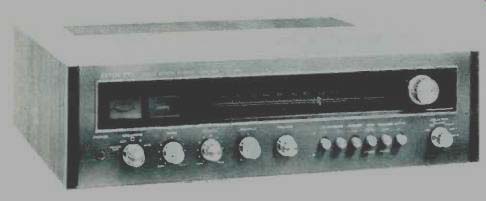
MANUFACTURER'S SPECIFICATIONS
FM TUNER SECTION
IHF Sensitivity: 2.0 µV. S/N: 70 dB. THD: Mono, 0.2%; Stereo, 0.5%. Capture Ratio: 1.5 dB. Selectivity: 75 dB. AM Suppression: 50 dB. Image Rejection: 70 dB. I.F. Rejection: 100 dB. Frequency Response: 30-15,000 Hz ±0.5 dB. Stereo Separation: 40 dB at 400 Hz.
AM TUNER SECTION
IHF Sensitivity: 40 V. S/N: 40 dB. THD: 0.8%. Image Rejection: 40 dB. I.F. Rejection: 40 dB.
AMPLIFIER SECTION
Power Output: 40 watts continuous per channel, 8 ohm loads, both channels driven. THD: 0.3% at rated power. IM Distortion: 0.4% at rated power; 0.3% at 1 watt output. Power Bandwidth: 15-35,000 Hz. Frequency Response: 10 Hz to 35,000 Hz +1 dB. Damping Factor: Over 100. Input Sensitivity: Phono, 2.5 mV; Aux, 100 mV. Phono Input Overload: 200 mV. Equalization: RIAA ±0.5 dB. Tone Control Range: Bass, +10 dB at 100 Hz; Treble, +10 dB at 10,000 Hz.
GENERAL SPECIFICATIONS
Power Requirement: 120 VAC, 60 Hz, 250 Watts, max.
Dimensions: 18 3/8 in. W. x 51 in. H. x 15 1/4 in. D.
Weight: 28 lbs.
Price: S399.95.
This entry from Onkyo is the first receiver of theirs we have had a chance to test and we were at once impressed by the fine external styling of the unit as well as by its neat internal layout and construction. The front panel is a heavy pale-gold-anodized casting, with solid end-cap posts which give the unit a very trim look.
The framed dial scale area, which also contains a single signal-strength meter active for both AM and FM, is blacked out until power is applied, at which time it is illuminated in bright green, with separate red illumination applied to the tip of the translucent dial pointer. Illumination to the meter face is applied only when a radio position (either AM or FM) is selected. Controls located along the lower section of the panel include a speaker switch (with settings for one or two pairs of speakers and an off position for headphone listening), dual-concentric, clutch-operated bass and treble controls, balance control, volume control and program selector switch.
In addition, there are six push-push buttons which control such secondary functions as high and low cut filters, stereo/ mono mode, tape monitoring, loudness compensation and FM muting. The usual stereophone jack is located at the extreme left of the panel, while the large tuning knob is positioned to the right of the dial scale. The FM dial scale itself is perfectly linear, with equal divisions between each MHz and, probably for this reason, Onkyo elected not to include a logging scale.

Fig. 1-Rear panel layout.
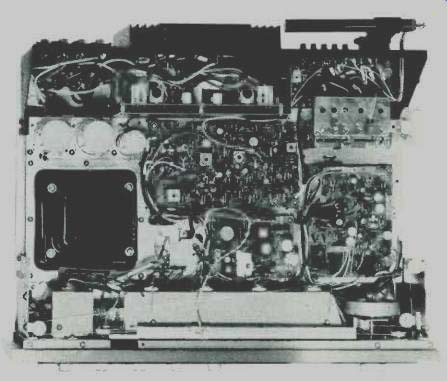
Fig. 2-Internal view from above.
A view of the rear panel is shown in Fig. 1. Speaker connection terminals are well spaced and are of the binding post type which permit the stripped ends of the speaker cable to be inserted in a small hole and retained in place by tightening a screw terminal. There are antenna connections for 300 ohm, 75 ohm, and "local" FM (used when attenuation of overly-close station signals is desired). There is also a terminal for connection of an external AM antenna in the event that the included ferrite bar antenna proves inadequate for weak-signal AM reception. Input jacks are provided for phono, and two sets of Aux equipment. An interesting innovation in the record-out system is the incorporation of two pairs of Rec Out jacks. The first set operates as expected, in conjunction with the front panel tape monitoring switch and the playback jacks on the rear panel. The second Rec Out jack set is located after the volume control and tone control circuitry, permitting the recordist to alter tone quality of the program prior to recording. This latter jack set does not permit tape monitoring, however. A DIN tape connector is also included, and it is wired in parallel with the Rec 1 and Playback jacks in the usual manner. A pair of speaker fuses, a line fuse and a switched and unswitched a.c. receptacle complete the rear panel layout.
Figure 2 shows a view of the inside of the chassis, and the modular construction is apparent. Several of the p.c. board modules are interconnected by multi-conductor plugs and sockets which permits easy servicing or replacement, if ever needed. The front-end features a four-gang tuning capacitor for FM (2 gangs for AM), double-tuned interstage circuitry and an FET r.f. amplifier. Three pairs of ceramic filters are used to set i.f. selectivity and a four-stage differential amplifier is used to achieve necessary gain and limiting functions.
Negative-feedback type tone controls are used in the voltage amplifier section, while the power amplifier is completely direct-coupled right out to the speaker terminals. An electronic protection circuit is included to protect against short-circuits in addition to the speaker fuses already noted. Transients or "popping" sounds of turn-on and turn-off have been eliminated by another circuit which Onkyo calls a "transient killer circuit."
Tuner Measurements
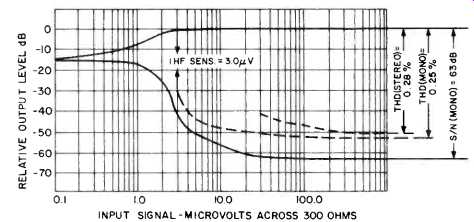
Fig. 3-FM performance characteristics.
As indicated in Fig. 3, IHF sensitivity was achieved for an input of exactly 3.0 microvolts. Fairly steep quieting was observed, with a 50 dB S/N reached for a bit over 4µV input. Ultimate S/N reached 63 dB at just under 100 µV, while mono THD reached a low of 0.25% for signal inputs above 100 µV. Stereo THD reached a low of 0.28%, considerably better than the 0.5% claimed. Stereo threshold sensitivity is not adjustable on this receiver, and we found that it took some 30 µV of signal before the receiver "switched over" to stereo operation. In view of the fact that THD at this input level was already below 1.0% and quieting was quite good, Onkyo would have been well advised to factory adjust the stereo threshold to a lower setting--say about 10 µV or so--so that listeners might enjoy stereo reception for weaker signal strengths.
Stereo FM separation fell short of the 40 dB claimed by the manufacturer, as shown in Fig. 4. Mid-band separation ranged from about 30 dB to 33 dB, with separation decreasing to 25 dB at 50 Hz and about 24 dB at 10 kHz. Mono distortion at various frequencies is also shown in Fig. 3 and is seen to remain well below 0.5% for frequencies from 80 Hz to 9 kHz and below 1.0% over the entire useful audio range of FM transmission. Stereo THD is just a bit higher than mono THD (0.28% at mid-band frequencies) for most of the audio range, increasing because of non-harmonic related "beats" as higher frequencies were tested.
Capture ratio measured exactly 1.5 dB with 1000 µV input, as claimed, and rose to about 1.8 dB for signals of 100 µV. Selectivity measured 70 dB, a very respectable figure even if short of the 75 dB claimed by the manufacturer. Frequency response was well within the ±0.5% limits quoted by the manufacturer, indicating careful choice of de-emphasis components and i.f. design.
AM performance was typical of that attainable with two-section tuning (signal fed directly to converter), and the 40 µV sensitivity claimed was confirmed.
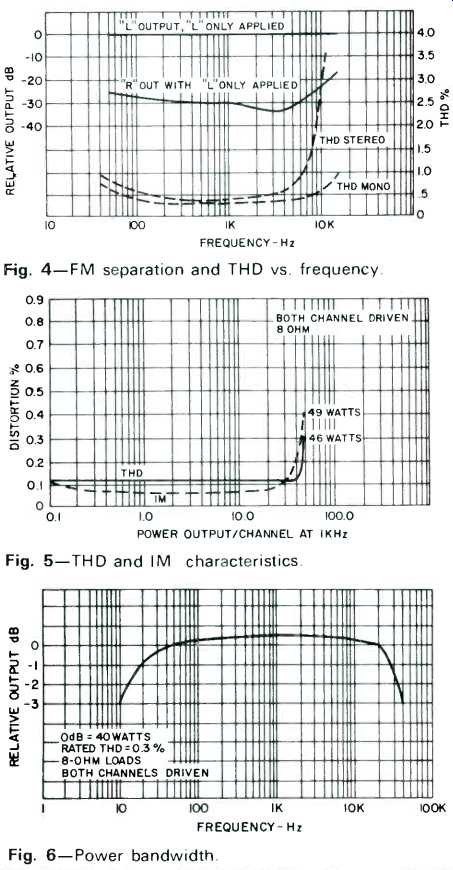
Fig. 4-FM separation and THD vs. frequency.
Amplifier Measurements
Fig. 5-THD and IM characteristics (see above)
Fig. 6-Power bandwidth. (see above)
The Onkyo TX-555 power amplifier section is extremely conservatively rated and a winner in every sense. THD for all power levels right up to rated 40 watts per channel hovered just over 0.1% and did not reach rated THD of 0.3% until each channel was producing 46 watts, as shown graphically in Fig. 5. IM distortion remained below 0.1% for all power levels up to about 30 watts and reached its rated value of 0.4% at 49 watts output per channel. Based upon the manufacturer's rated output of 40 watts per channel into 8 ohm loads, power bandwidth extended from 10 Hz to 40 kHz, considerably better than claimed. Power bandwidth is plotted in Fig. 6. The power amplifier easily produced rated power at all frequencies from 20 Hz to well over 20 kHz. Even at 20 Hz, THD measured 0.6%, as shown in Fig. 7. THD at half power and 1 watt levels was proportionately better at the frequency extremes as shown.
Phono input sensitivity was confirmed as 2.5 mV and, more important, the overload input signal capability was measured as 225 mV as against the 200 mV claimed. This is an extremely worthwhile feature, in that it insures absence of distortion when playing today's dynamically recorded discs with virtually any cartridge, regardless of its nominal output level.
Phono hum and noise was measured as 60 dB below full output, with reference to a 2.5 mV signal input. Referenced to a 5 mV input signal (more typical), the hum and noise level becomes 66 dB and very acceptable. S/N ratio for the Aux input was 75 dB below rated output while residual hum and noise of the power amplifier was measured as 90 dB.
Tone control range, filter action, and loudness control action with volume control set at -30 dB are all plotted in Fig. 8 and are seen to conform to manufacturer's claims and standard practice. The loudness control compensates both bass and treble extremes, with the treble emphasis being moderate. Overall frequency response, including low level amplification and tone control stages, extends from 9 Hz to over 30 kHz within 1 dB.
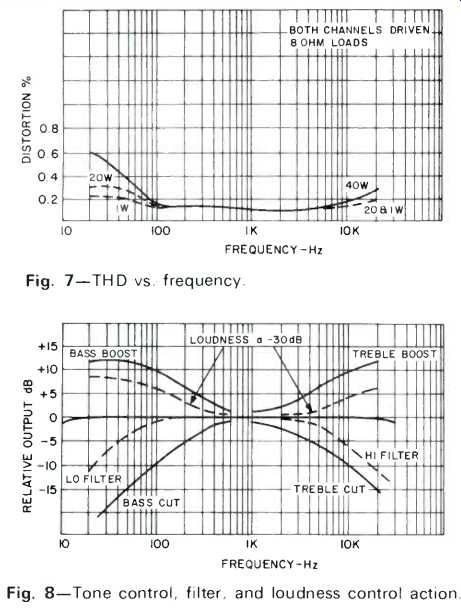
Fig. 7-THD vs. frequency.
Fig.
8-Tone control, filter, and loudness control action.
Listening Tests
FM reception using the Onkyo TX-555 was highly satisfactory, with good quieting and distortion free performance on most all of the 45 stations we logged. We were not conscious that the IHF sensitivity and stereo FM separation measured less than some of the "super tuners" we have recently tested, which proves once more that these particular parameters are of lesser importance than we are led to believe. We were, however, aware of the high stereo threshold point, since some three or four stations (admittedly at great distances from our receiving site) were received in mono when we knew that they were broadcasting in stereo. Our field strength meter indicated a signal strength of 25 µV for the strongest of these, confirming that it does take more than 30 µV to "flip" this receiver into the stereo mode. Of course, most typical listening involves signal strengths greatly in excess of that figure-providing you use a reasonable FM antenna.
It was in the phono mode that this receiver really came into its own. Transient response seemed excellent and even our most dynamically recorded discs were heard without any discernible overload distortion or breakup. As for power output, it was more than adequate for our stereo pair of low-efficiency acoustic suspension systems which call for a nominal 20 watts of power per channel. Low-level listening was also very clean, sonic evidence of the low distortion figures observed during our lab measurements. Controls were smooth and easy to use, and volume control tracking was particularly accurate to below -60 dB from full volume.
At just under $400.00, the Onkyo TX-555 represents good value for anyone interested in a receiver in the 40+ watt per channel power range. At $469.95, the company offers another model (TX-666) which is reported to have somewhat better FM performance and 50 watts per channel output. If the higher powered set is as conservatively rated as this one, both receivers deserve serious consideration in their respective power classes.
-Leonard Feldman
(adapted from Audio magazine, Oct. 1973)
Also see:
Onkyo Model A-7 Integrated Amplifier (Jan. 1978)
Onkyo Model 20 speaker system (Equip. Profile, Jan. 1973)
= = = =